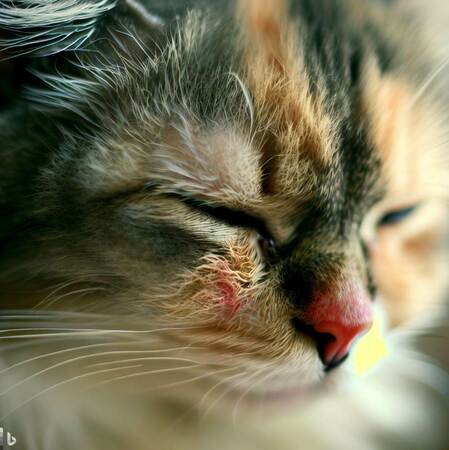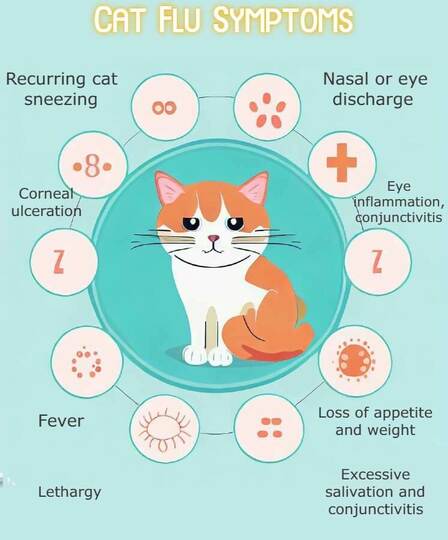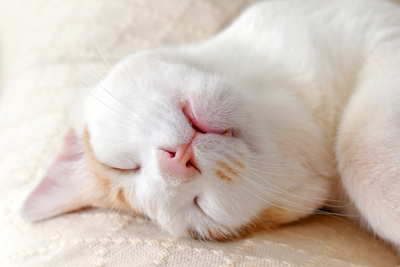Cat Flu Symptoms NZ
Is your cat suffering from cat flu/cat herpes?
We’re here to help!
Noticed something a little off about your cat? You might be worried about your furry friend catching the flu. Let's talk about what cat flu (also known as cat herpes) is and what you can do to keep your pet healthy and comfortable.
What is cat flu?

Cat flu is an acute infection of the upper respiratory tract of cats. It is also known as Feline Herpes Virus, Feline Viral Rhinotracheitis (FVR) or Rhinotracheitis. It is caused by several felines, bacteria and viruses and is the cause of up to 40-45% of cats with upper respiratory tract infections.
The effects of cat flu on infected cats
The incubation period for FVR is between 2-17 days. There will initially be a fever with ocular (eye) and nasal discharge, which can become quite copious. The cat may become depressed and visibly lose weight. Signs of the disease can last for up to 6 days in milder cases and up to 6 weeks in more severe cases.
Is cat flu dangerous for my cat?
The mortality rate for cat flu is low. It is self-limiting, so most cats will recover well, but up to 80% will become a lifetime carriers of the virus. In addition, there may be recurrent infections when the cat's immune system is compromised during stress or other infections or illnesses.
There can sometimes be secondary bacterial infections associated with FVR that will follow after the disease, with more severe cases developing into ulcerative stomatitis. Therefore, you should seek veterinary advice if you are concerned with your cat's health.
Looking after your other cats
Cat flu is a highly contagious disease spread via cat sneezing, cat-to-cat contact, or owner-to-cat contact through bowls, toys and bedding. Humans can't get cat flu. However, kittens, elderly or immune-compromised cats are more at risk. It is more likely found in stray cats, boarding catteries, shelters and more than one cat household.
What causes cat flu?
The two main viruses that cause 90% of infections are Feline Herpes Virus (FHV) and Feline Calici Virus (FCV).
Cat Flu Symptoms
It’s important to know what to look out for. Here’s a rundown of cat herpes symptoms:
- Recurring cat sneezing
- Nasal or eye discharge that can either be bland or acrid and burning, ranging from clear, cream, and yellowish to green
- Eye inflammation, conjunctivitis
- Corneal ulceration
- Fever
- Loss of appetite and weight
- Excessive salivation and conjunctivitis
- Lethargy

How is cat flu diagnosed?
Your veterinarian will go off the main symptoms your cat presents and will be able to run tests to rule out other diseases.
Prevent cat flu with these simple steps
- Keeping your cat well-hydrated is very important, as it will lose a lot of fluids.
- Ensure your cat has a good nutritious diet
- Keep the eyes and nose clean of discharge
- Keep them away from other cats, as the disease is very contagious
- Antibiotics may need to be administered if a secondary infection has developed.
We offer natural remedies for cat flu symptoms in NZ
Natural Pet has Feline Sniffles in our Tagiwig range, designed specifically for cat flu and upper respiratory infections in cats. It can help with all symptoms associated with the disease and give your cat relief.
Another remedy that can help to support your cat is Immune Tonic to help boost its immune system.
If they have had antibiotics, our Poly Bowel Plus will help restore and balance the gut, and our Liver Tonic (Hom) will support and cleanse the liver.
You can get veterinary vaccinations against cat flu. If you are worried about these side effects for your cat, check out our Vax Detox Kit Feline. It will detox your cat and assist with any long-term side effects. If they have reacted to their vaccination, don't hesitate to contact us, and we can discuss how we can help.
FAQs
How common is cat flu in New Zealand?
Cat flu is a relatively common disease in New Zealand, as it is in many other countries around the world. Cat flu is more common in cats that are under one year of age, elderly cats, and cats with weakened immune systems.
Is cat flu dangerous for my cat?
The mortality rate for cat flu is low and most cats will recover well, but up to 80% will become lifetime carriers of the virus. Recurrent infections may occur when the cat"s immune system is compromised during stress, other infections, or illnesses. Secondary bacterial infections associated with FVR can also occur, leading to ulcerative stomatitis. Seeking veterinary advice is recommended if you’re concerned with your cat's health.
Can humans catch cat flu?
Cat flu is a contagious disease that affects cats, but it cannot be transmitted to humans. Although some symptoms of cat flu, such as sneezing and coughing, may be similar to those of the common cold or flu in humans, the viruses and bacteria that cause cat flu are specific to felines and cannot be transmitted to people.
How is cat flu treated?
Treatment for cat flu may include supportive care such as fluids and nutrition. Building up a cat’s health will also stop the severity of cat flu. At Natural Pet, we offer natural alternatives to treat cat flu so it doesn’t develop into secondary bacterial infections.
Posted: Wednesday 30 August 2023




